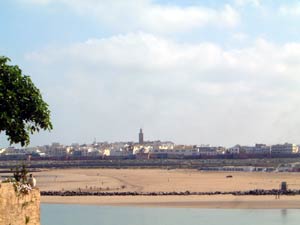 Sela [Sale] is an ancient city, built by the Romans and conquered
by the Goths. When the Muslims invaded the region, the Goths handed
the city over to Tarek. When Fes was built, Sale came under its authority.
Sela [Sale] is an ancient city, built by the Romans and conquered
by the Goths. When the Muslims invaded the region, the Goths handed
the city over to Tarek. When Fes was built, Sale came under its authority.
This
town is built on the coast, on a beautiful site. It is no more than
one mile away from Rabat; the Bu Regreg river flows between the two
cities. Houses are built in the traditional way, ornate with mosaics
and marble columns. So are the shops, built in fancy arcades. Sela once
displayed all the luxuries of a great town and of a great port which
received ships from Genoa, Venice, England and Belgium, and was the
main port of Fes. But this town was captured by the King of Castille
[Spain] in 658 [1260]. The population fled, and the Christians stayed
for 10 days until the first ruler of the Merinide dynasty, Jacob retaliated
and killed all of them.
While
Sela was almost immediately re-conquered [by the Moroccans] it lost
much of its population and refinement. There are many empty houses,
beautiful examples of past craft, but people don't seem to appreciate
them.
The
land around Sela is all sand, aside from a few fields where they grow
wheat. There are many gardens, as well as cotton fields. The city dwellers
are mostly weavers and make cotton fabric of fine quality. People from
Sela also make a great many combs which they sell all across the kingdom
of Fes: the forests near the city provide the wood for this craft.
Today
one can live comfortably in Sela. There is a governor, a judge and other
officials, some of whom work with the many Genoese who trade there.
The King is quite generous with them as their trade brings in much wealth.
These merchants are to be found both in Sela and Fes. They are very
honest and polite men, spending great sums to secure the friendship
of local lords- not to abuse of their trust, but simply to live well
in Morocco.
I
once knew a remarkable Genoese man named Messire Thomasso de Marino.
He lived in Fes for thirty years and when he died, the King of Fes sent
his body to Genoa, as the latter had requested. This man left behind
many sons, all of whom were greatly respected in the Fes court. "
(Leo, 171)